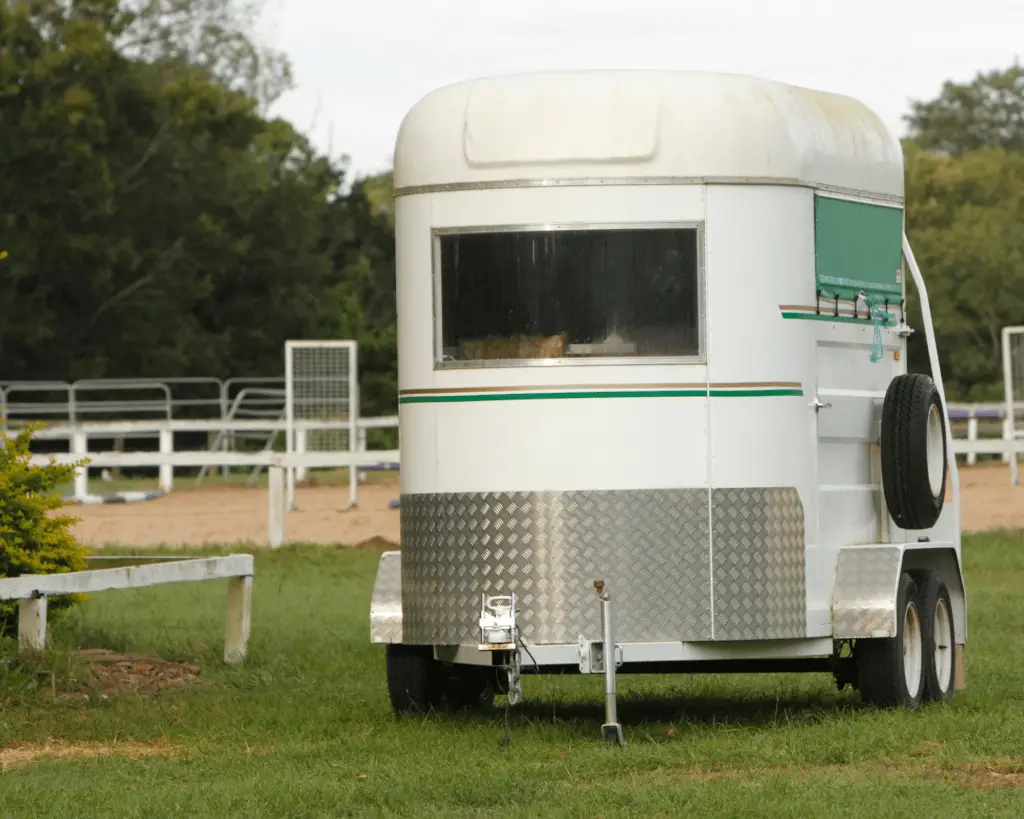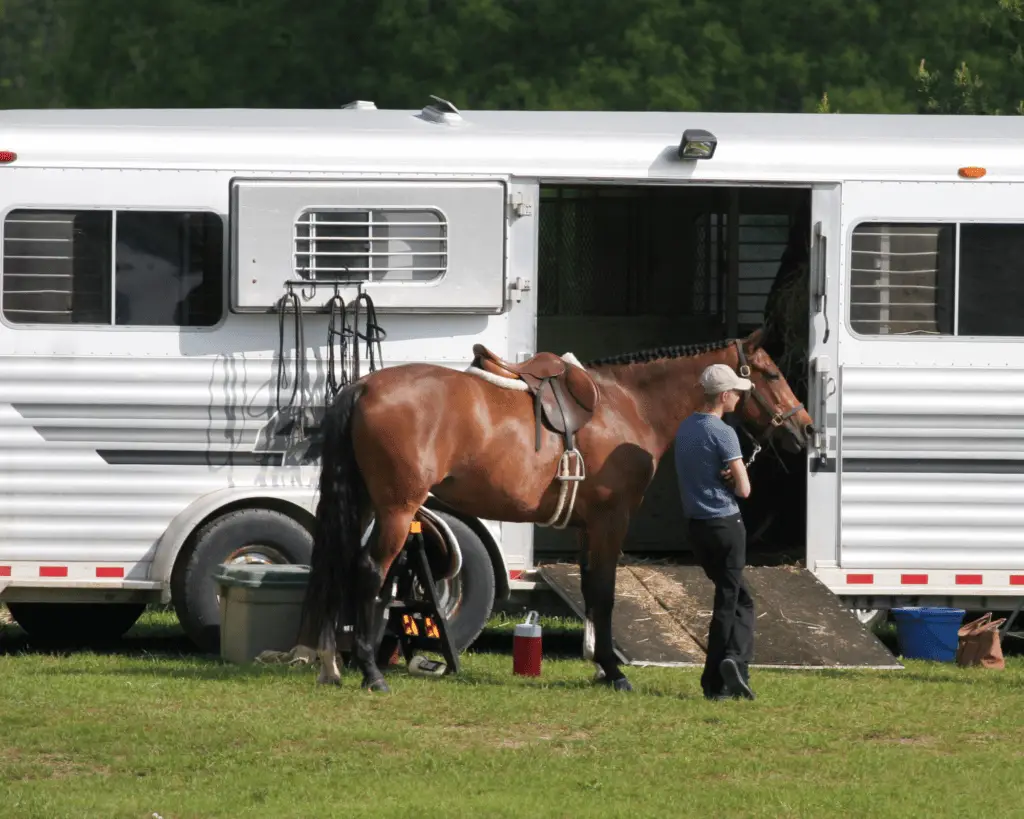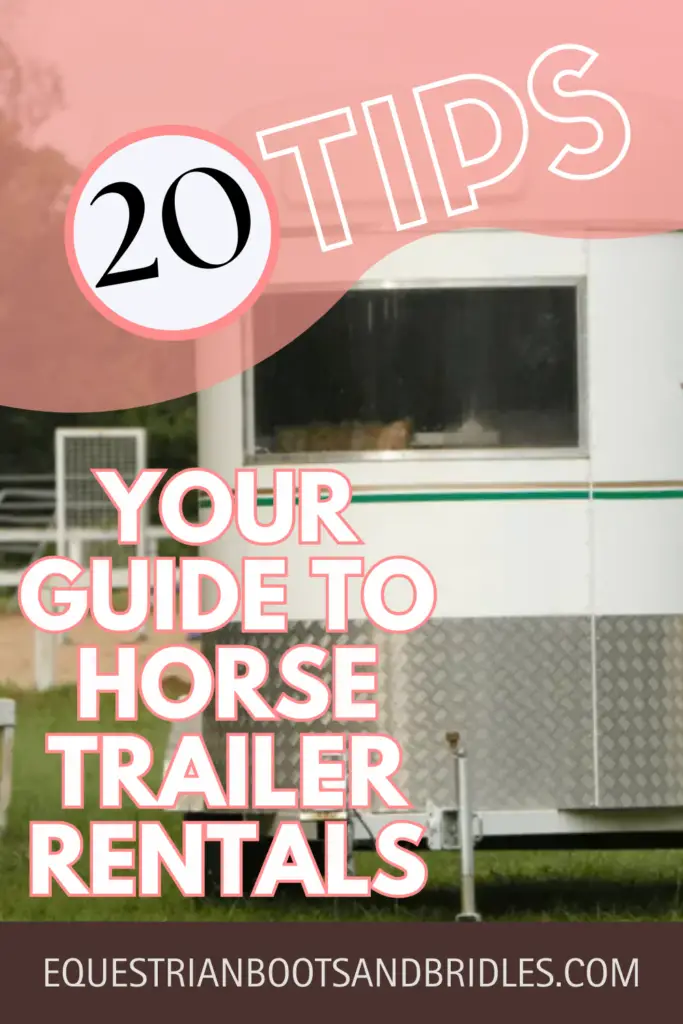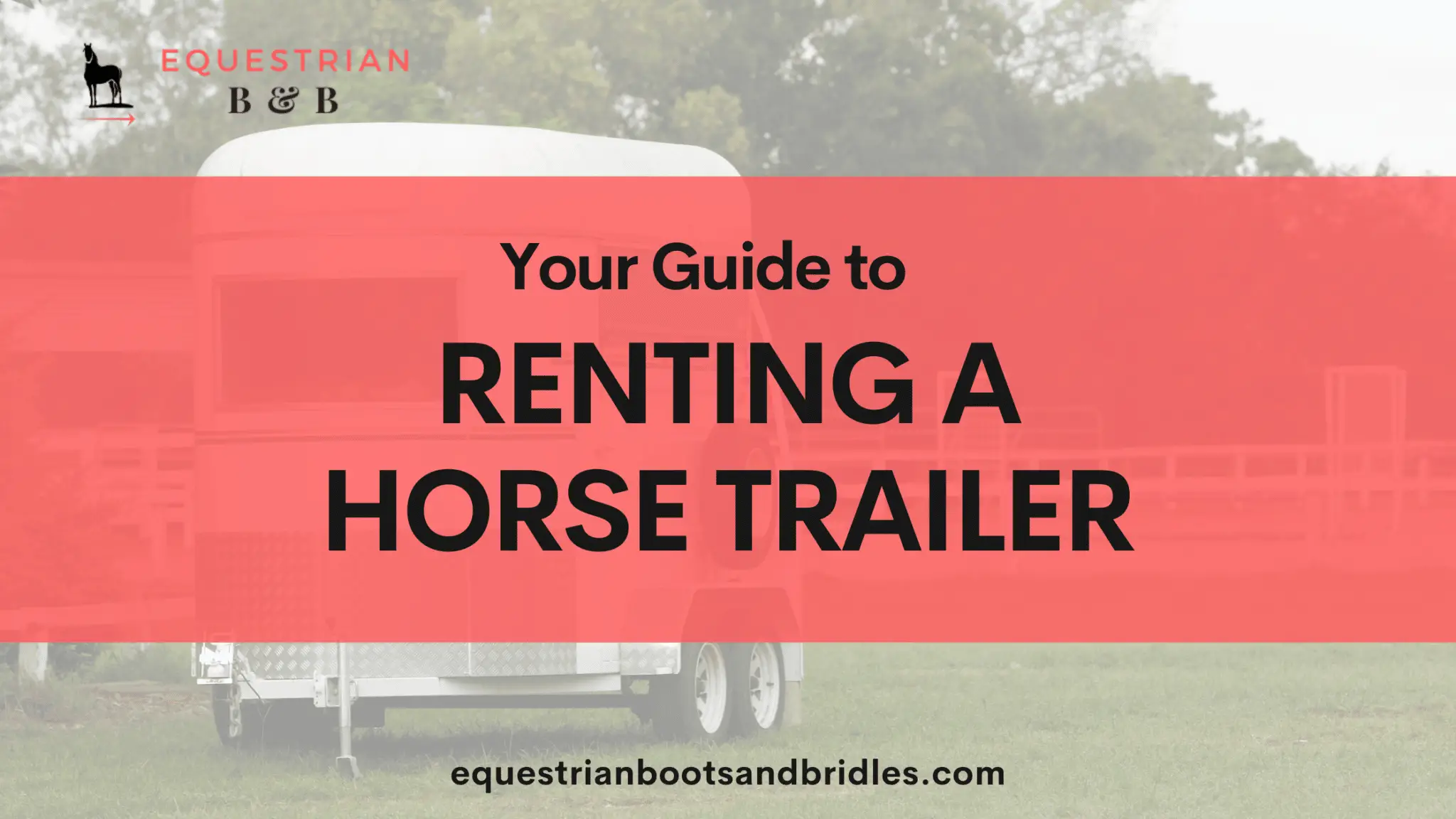Owning a horse trailer isn’t practical for many horse owners, but sometimes you find that you need to trailer your horse for a non-emergency need. Maybe you’re taking your horse to the vet clinic, going on a horseback riding trip, or you want to work with a clinician who isn’t able to come to your barn. Getting to any of these destinations with your horse requires the use of a trailer, and you can rent one for as long as you need to use it.
Before you sign a contract for a horse trailer rental, you want to make sure that the trailer you’re about to use is sound and functional. That means inspecting the body for rust, holes, damage, and making sure that locks, doors, and partitions work as intended. The following guide explains what you need to look for in a horse trailer rental and the type of tow vehicle you’ll need for an uneventful towing experience.
P.S. If you need help learning how to actually get your horse into the trailer, check out this article.
Cost of Renting a Trailer
The cost of a trailer rental depends on where you live and the demand for rentals during the time you need to use one. When you search for “horse trailer rental near me,” you’ll get plenty of hits, but you might not get a good idea of what it will actually cost. You can usually expect to pay anywhere from $75 to $200 USD a day for a rental, depending on the type of trailer you need to use.
Horse Trailer Insurance
The horse trailer rental agency will offer an insurance policy that provides coverage in case of an accident while you’re using the trailer. You can sign up for the policy or you can arrange to get a policy that adds on to your existing auto insurance coverage. Regardless, it’s a good idea to have insurance for the rental, especially because you’re towing your horse and equipment in a trailer you don’t own.
You can read our comprehensive guide to horse trailer insurance here.
Ask Friends & Check Reviews
Outside of just Googling for “horse trailer rental in [your area],” one of the best ways to find a trustworthy company is to ask fellow horse-riding friends and/or members of the barn where you board. Checking Facebook groups, Reddit, or other local message boards for recommendations is another great way to find companies that others in your city have already vetted.
Of course, checking reviews on Google, Facebook, Yelp, etc. is another great way to find out what kinds of experiences others have had with the various horse trailer companies around you, thus reducing your risk.
The hope is that once you find a trustworthy company, you can use them over and over again, which will save you a lot of time researching in the future!
Inspecting the Trailer for Safety
You’re towing precious cargo, which means you need to make sure that the trailer is in good condition and won’t put your horse at risk of injury. The following are key details you should look at before you back up your tow vehicle to the trailer hitch.
Floor condition
The floor of the trailer needs to be solid, have no holes, and no loose planks if it has a wood floor. If the floor is metal and has rubber mats on top, lift up the mats (if possible) to look for holes in the metal. A welded patch over a hole is okay as it shows the trailer has been maintained and there’s a mat over the patch to prevent a hoof getting snagged. New wood planks also indicate that the trailer has been maintained and is safe for a horse.
Wiring
Many trailers have exposed wiring due to their simple construction. That is, you can reach into the ledge between the roof and the side and feel the wiring harness. This results in wires that are easily pulled down by a curious mouth, have the coating rub off, and connections can break that cause a short in the lights. If you see wires dangling, take a look to see if any of these conditions are present.
Trailer plug
The trailer plug is easily damaged because it’s left hanging loose when not in use. Make sure there are no bent pins in the plug and that the wiring to the trailer connects to the plug. The plug controls lights, turn signals, and trailer brakes, which is why an inspection is important. It’s also something that’s easily damaged due to how it’s “stored” when not in use.
Ball lock
Both a fifth wheel and bumper pull hitch have some kind of lock to hold the receiver to the ball. Make sure that the lock and spring are in good working order by sliding the collar back and forth. You’ll hear a click or see the receiver lock into place, depending on the lock design. If the collar doesn’t lock, don’t take the trailer.
Body condition
Trailers are frequently made of steel and are prone to rust no matter how well they’re taken care of. Check the seams where the body meets the floor of the trailer to look for substantial holes. You don’t have to concern yourself with a small hole, but if the hole is big enough for a hoof to go through, or can be easily eroded with your fingers, pass on the trailer. Metal weakened by rust is fragile and can be easily opened up by a stray strike from a hoof.
Tire tread
Trailers usually use something known as a bias-ply tire. They’re great for use on trailers due to their strength, but they tend to have less in the way of tread. However, the Lincoln penny trick works on trailer tires. This is where you put a penny into the tread, with Abe’s head down, and look to see if the tread is at the top of Abe’s head. Does the tread go past Abe’s hairline? If so, the tires are fine. If not, the tires are worn and at risk of a blowout.
Also, check the tires for cracks in the rubber. Cracks indicate the tires are old and starting to rot. They won’t hold air for long, which puts you at risk of being stranded until the tire can be changed.
Trailer brakes
Trailer brakes play a major role in trailer safety. They slow down the trailer at the same rate of speed as the car, enabling you to make it to the stoplight without running past the intersection. Plug the trailer into your tow vehicle and make sure you’re parked. Hit your brakes. You should hear the trailer brakes responding in time to your tow vehicle’s brakes. If you don’t hear noise, hook up the trailer and do a quick driving test to determine if the brakes are working or not.
Door latches
Check the door latches to make sure they shut firmly and stay shut. Push or pull on the door when it’s latched to find out if the latch is reliable or not. Accidents happen with latches, and sometimes their mechanisms fail without warning, but most of the time, this is avoidable by checking the latches first.
What Kind of Trailer Will You Need?

Trailers come in all shapes, sizes, configurations, and designs that fit your needs for whatever you’re towing. Here are some things you’ll want to consider:
Ramp or no ramp
Regardless of trailer style, you’ll want to think about whether or not you need a ramp. Some horses prefer to leap into a trailer, while others prefer to walk up a ramp. If your horse hates ramps, but that’s the only style you can find, use straw or shavings on the ramp to give the horse a visual cue that it’s safe to walk on.
Stock trailer
A stock trailer is great for towing a horse that won’t load into a small or dark trailer. It’s also great for horses that need to travel loose, especially when there’s a partition door. You can close the door and let the horse loose while your cargo goes on the other side. Stock trailers tend to not come with ramps, but do have wide entry doors and make it easy for an anxious horse to step or jump into.
Straight load
A straight load trailer, or side-by-side, lets you load two or four horses in a side-by-side configuration. They tend to be the narrowest type of trailer, and are good for towing to shows, clinics, and the vet’s office. If you’re going on a longer trip, you should consider a slant load or a stock trailer to keep your horse comfortable.
Slant load
If you’re going away for the weekend to a show, a two horse straight or slant is ideal. A trailer with living quarters is great for longer trips to a national park or state forest preserve where camping is allowed. The number of horses you’re hauling along with the need for the trailer dictates the size and type of trailer you’ll need to rent.
Horses do fine when being transported in a straight load trailer, but they handle the stress of trailering better when they’re on a slant or allowed to travel loose. The dividing panels in a slant load help a horse support themselves against the motion of the trailer, as does trailering loose.
Fifth wheel or bumper pull
Bumper pulls are easier to tow, but it’s harder to balance their weight for efficient towing. A fifth-wheel does a better job of distributing the weight over the rear axle of the tow vehicle, but is a little more challenging to handle due to a tighter turning radius. Bumper pull trailers track the wheels of your tow vehicle, whereas a fifth wheel turns at an angle to your tow vehicle. It’s far easier to jackknife a fifth wheel trailer than a bumper pull.
Use an Appropriate Tow Vehicle

It is possible to tow a two-horse trailer with a small SUV, but you can also technically tow that trailer with a garden tractor! It’s doable, just not advisable. The exception is if you have access to a European trailer that’s designed for use with mid-sized SUVs. Otherwise, you’ll need a half-ton truck with a regular length bed at the very least.
This is due to the fact that the physics of towing requires the use of an engine that has high torque output, a transmission designed for towing, and a wheelbase that’s capable of staying stable when towing something large and slightly unbalanced behind it.
Half-ton trucks typically have enough towing strength to handle up to 12,000 pounds in weight. That’s more than enough power for towing a 3500-pound stock trailer with two average-sized horses, personal gear, tack, and feed for your trip. You may lose power on hills and have slow acceleration, but as long as you let the engine build torque, you’ll do okay and get to where you’re going on time. Building torque for towing is easy: gently press on the accelerator and let the engine gain speed. Adjust the pressure on the accelerator when the engine sound levels off and you’re not accelerating, but need more speed.
A 3/4 or one-ton pickup is better for towing due to its heavy duty construction. However, if you can’t get your hands on either one, a half-ton is still viable.
Vans that are in the same weight class as a pickup truck can also be used for towing a bumper pull. Make sure to check that the van is set up for trailering and make sure to stay under its maximum weight limit for towing. Using a van comes with the need to consider its own gross vehicle weight rating along with what it’s capable of towing.
Always Practice Safe Towing
When you tow, you can’t drive the same as you normally would. Take it slow, resist the urge to accelerate fast, and give yourself plenty of stopping distance. Don’t worry about other drivers getting irritated with you, as you have a cargo to protect. Focus on gentle acceleration, soft stops, and wide turning radiuses to give your horse the opportunity to compensate for the movement with the least amount of stress.
All horses experience stress when in a trailer, and that includes seasoned trailer veterans. They have no warning that you’re about to accelerate or decelerate, and need an opportunity to adjust or brace themselves for motion. Make it a point to go easy on them by accelerating and braking as gently as possible, use an appropriate trailer and tow vehicle, and giving yourself plenty of time to reach your destination.
In Conclusion
This guide is intended to help you do the right thing when it comes to a horse trailer rental. You won’t need a lot of time to go over the trailer in search of defects as it’s pretty easy to see when there’s a problem. Taking the time, however, saves you from all kinds of heartache from the moment you hook up the trailer to the time you return the trailer after you’re done with it.
Like this post? Save it on Pinterest. Follow me on Pinterest.


